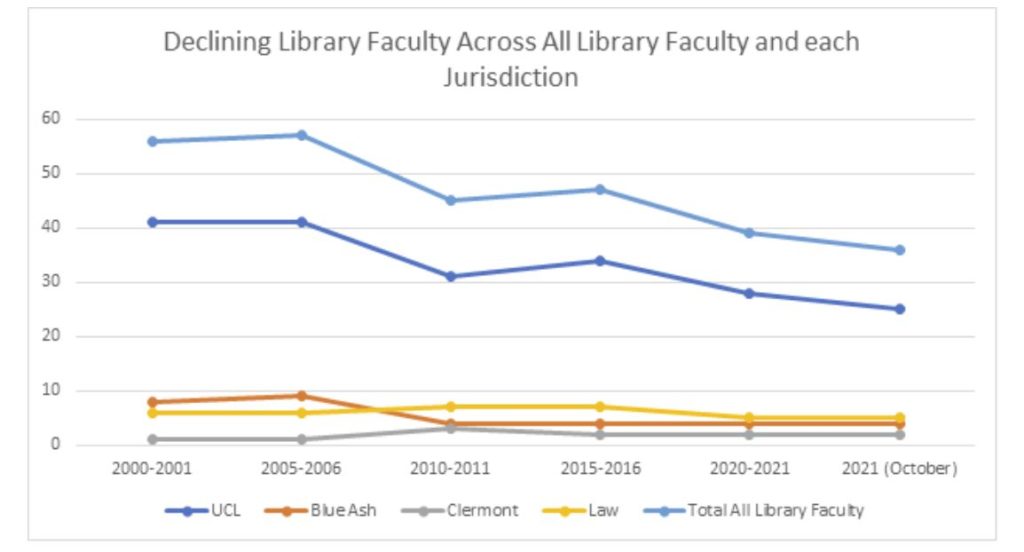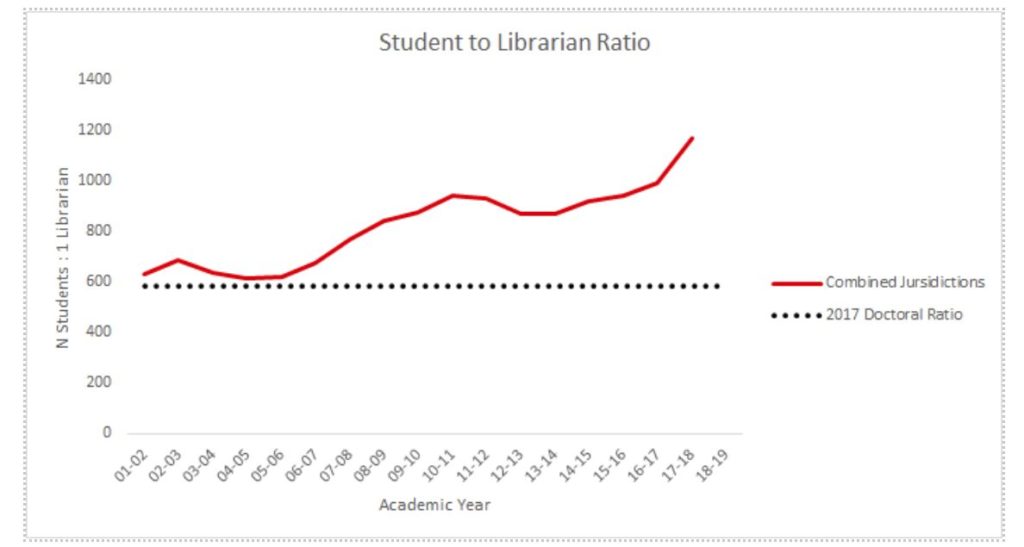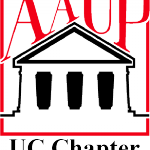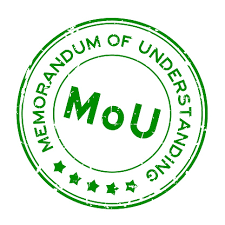In this issue:
- All-Library Faculty Ad Hoc Census Data Group
- Triage Training Begins
- Bargaining Survey
- Ohio Divisive Bills Updates
- Next Chapter Meeting
 All-Library Faculty Ad Hoc Census Data Group
All-Library Faculty Ad Hoc Census Data Group
Introduction
Librarians at the University of Cincinnati are in the midst of a quiet but increasingly dire workforce crisis. Since 2000, there has been a 36% decline in the numbers of overall library faculty (from 56 to 36 librarian faculty). Librarians work at one of four library jurisdictions: the largest jurisdiction, UC Libraries (UCL) which consists of 10 locations across east and west Clifton campus, the UC College of Law Library, UC Blue Ash College Library, and UC Clermont College Library (ref #1). Most of the loss has been driven by declines in the largest UCL jurisdiction, which has suffered a 26% decline of its librarian faculty numbers since 2015 alone (from 34 to 25 UCL librarian faculty). Despite growing enrollments and a continued high demand for library collections and services, faculty positions have not been replaced at the rate at which they’re lost through retirements and resignations. As a result, the services, collections, and remaining faculty of the libraries are suffering under great strain, with serious ramifications for the educational and research mission of the university.

Impact on Student Education and Librarian to Student Ratios
As UC’s enrollment has grown, we employ below the number of librarians needed to serve our growing student population. Not all librarians work directly with students, but the work of all librarians is essential to providing the services, instruction, and collections necessary for student academic success. When capacity allows, librarians can provide high-impact practices that enable student success such as embedded librarianship in courses or having direct interactions with students. Faculty who work with library faculty find improvements in student projects while students gain a vital connection to university resources and experience performance improvements. With decreasing library faculty numbers, those meaningful connections that impact student learning become difficult if not impossible for those who need it most.
According to the most recent available data from the American Library Association (ref #2), the average doctoral institution librarian to student staffing ratio is 1 librarian to is 587.61 students (derived from 30.68 FTE librarians per 18,028 students). However, at the University of Cincinnati, our librarian to student ratio is dramatically below the average for other doctoral institutions. In 2019, the librarian to student staffing ratio across the entire university was 1 librarian to 1,258.49 students (of any enrollment type, based on IPEDS fall enrollment head count) (ref #3).

Peer Comparisons for Library Employees
The University of Cincinnati is a member of the Association of Research Libraries (ARL), a group of 120 research libraries across the United States and Canada. The Association of Research Libraries routinely gathers data about its member institutions, including expenditures on collections and staff, staffing levels, and collections holdings. One way to contextualize the staffing situation at UC Libraries is to look at the “aspirational benchmarks” the University has provided in other venues. The institutions UC uses as aspirational benchmarks routinely vary, but a recent list can be found in the recent “Report of the Graduate School Envisioning Committee” (ref #4) commissioned by Provost Kristi Nelson.
The report included 10 institutions as benchmarks: Nine of these are ARL institutions, except for University of South Florida.
- Georgia Tech, Atlanta, Georgia
- Ohio State University, Columbus, Ohio
- Temple University, Philadelphia, Pennsylvania
- University of California San Diego, San Diego, California
- University of Illinois at Chicago, Chicago, Illinois
- University of Minnesota, Minneapolis, Minnesota
- University of Pittsburgh, Pittsburgh, Pennsylvania
- University of South Florida, Tampa, Florida
- University of Washington, Seattle, Washington
- University of Michigan, Ann Arbor, Michigan
With only one exception, every benchmark institution has a larger workforce than the University of Cincinnati Libraries. The majority of these benchmarking institutions have much larger library workforces than the University of Cincinnati. The median value of all these institutions’ library workforce is 235 (inclusive of professional and support staff classifications), over 100 more employees than UC’s 130 employees in 2020 (ref #5).
Impact on UC Faculty Scholarship
Professionally trained information professionals build library collections that faculty rely on for their scholarship. Without sufficient faculty librarians, the size and specificity of collections will diminish to the detriment of scholarship (ref #6).
Having the tools necessary to do good research and scholarship is a major selling point of any institution. Having a well-resourced library with trained faculty supporting the collections and specialized services can draw high impact researchers and scholars to join our faculty and can also help retain them. This will attract more graduate students to our institution, helping us in the long term (ref #7).
Impact on the Global Research Community
It’s not just UC faculty, students, and staff who rely on the library resources. UC has important and rare Special Collections materials that many international researchers use, such as those at the Archives and Rare Books Library, Classics, DAAP, Oesper History of Chemistry collections, and the Health Sciences Library’s Winkler Center for the History of the Health Professions. Due to the very small numbers of employees in each of those locations, faculty and staff at these libraries can rarely keep up with user demands of these collections through in-person use and scanning requests, while also managing the daily work of caring for these rare and precious materials. Librarians who work with metadata, digitization, and cataloging are also essential to care for and promote library collections. These areas have also had significant librarian declines in recent years, meaning we are falling farther behind in critical areas of digital collections and digital preservation.
Among ARL member libraries reporting dedicated Special Collections staff numbers, UC has below average staffing, ranking 68th out of 81 reporting libraries. The median value is 9 FTE Special Collections Professional Librarians, in 2020 UC only had 5 FTE Special Collections Librarians (ref #5).
Conclusion
Despite rising enrollments and a focus on research in Next Lives Here, UC has failed to invest in its library faculty who perform vital work that contribute to faculty research and student success at the university. The decline in library faculty negatively impacts collections management, research support, and academic and curriculum services. These ongoing losses of faculty librarians impacts the university’s ability to flourish and generate the excitement and innovation described in our President’s vision. As the union moves into bargaining, we offer this data to AAUP members to inform our colleagues and to seek prioritization of actions to halt the ongoing decline of library faculty.
References
- The 10 libraries of the UCL jurisdiction include Archives and Rare Books, CCM, CEAS, CECH, Chemistry-Biology, Classics, DAAP, Geology-Mathematics-Physics, Health Sciences, and Langsam. https://libraries.uc.edu/about.html
- Kathy Y. Rosa, “Academic Libraries. The State of America’s Libraries 2019,” American Library Association, 2019, http://www.ala.org/news/state-americas-libraries-report-2019.
- “IPEDS Enrollment Survey,” National Center for Science and Engineering Statistics, retrieved August 23, 2021, https://ncsesdata.nsf.gov/builder/ipeds_e.
- “Report of the Graduate School Envisioning Committee,” Graduate School Envisioning Committee, September 2020, https://mailuc.sharepoint.com/sites/Provost/SitePages/Graduate-School-Task-Force-Issues-Final-Report.aspx.
- “Annual Library Statistics,” Association of Research Libraries, retrieved October 18, 2021, from https://www.arlstatistics.org/analytics.
- Danielle Cooper and Oya Rieger, “What’s the Big Deal?: How Researchers Are Navigating Changes to Journal Access,” Ithaka S+R, June 22, 2021, https://doi.org/10.18665/sr.315570.
- “The Value of Academic Libraries,” SCONUL, retrieved October 25, 2021, https://www.sconul.ac.uk/page/the-value-of-academic-libraries.
 Triage Training Begins!
Triage Training Begins!
Are you a member who is interested in getting more involved with your union? Are you maybe interested in working directly with other members to help them through contractual and other concerns and help alleviate the workload of our staff members? If so, please consider joining us! The AAUP-UC is searching for members willing to serve on small committees that will work directly with other members on contractual issues such as Article 7 RPT concerns, Article 15 equity issues, APR reviews, and workload documents. We have begun forming committees, and we are starting to train members this week. On Wednesday, November 10, from 11:00am – 12:00 noon, we will be conducting a virtual training on how to help members with Article 7, RPT issues and concerns. Training will continue throughout November and December, and the plan is to have committees in place and ready to help with triage by early spring semester. There is still plenty of time to get involved and help do your part in keeping our Chapter strong and engaged as we head into a bargaining year. If you are interested in attending the virtual training on November 10 or in joining another committee, please contact Cassie Fetters at fettercd@ucmail.uc.edu.
 Bargaining Survey
Bargaining Survey
As most of you likely know, the terms of bargaining unit faculty employment are determined by a Collective Bargaining Agreement that the AAUP-UC Chapter negotiates with UC’s administration. Our current CBA with UC is set to expire on June 30, 2022, and thus we will begin work on our next agreement with UC sometime in mid-spring semester.
The Executive Council has begun planning for the upcoming bargaining session, and an essential part of this process is to collect faculty input regarding which issues you feel are most important to bring up at the table. As part of this process, the Council has been listening to your comments at Chapter meetings, and, also, to those that you have sent via the Chapter Associates. They’ve also taken into account concerns raised at Faculty Senate and other governance gatherings.
A crucial component of this information-gathering process, however, is the Faculty Bargaining Survey, a survey we send out each fall before negotiations begin. This measure allows the Executive Council to gain a clear sense of the entire Bargaining Unit’s current priorities. Please be on the lookout for an email containing a link to this survey, and, once you receive the link, please take a few minutes to fill it out. In order for our Chapter leadership to best address your concerns, we need to hear from you!
 Ohio’s Divisive Concepts Bills
Ohio’s Divisive Concepts Bills
Updates to HB-327 and SB135 can be found on the Ohio Conference AAUP website: http://ocaaup.org/news/legislative-updates-hb-327-sb-135/
 AAUP-UC Chapter Meeting
AAUP-UC Chapter Meeting
Our next Chapter meeting will be on Thursday, November 18th at 12:30 via Zoom. Details with the Zoom link and agenda will be emailed to our members soon. We hope to see many of you there.


 MOU Vaccine Mandate
MOU Vaccine Mandate Joint Committee Report Inspires Beginnings of Progress
Joint Committee Report Inspires Beginnings of Progress Response to President Pinto
Response to President Pinto
